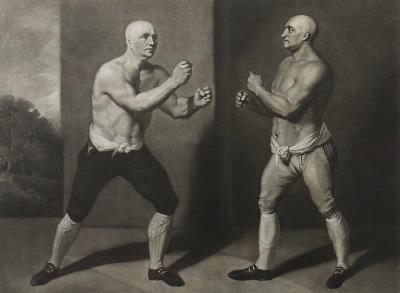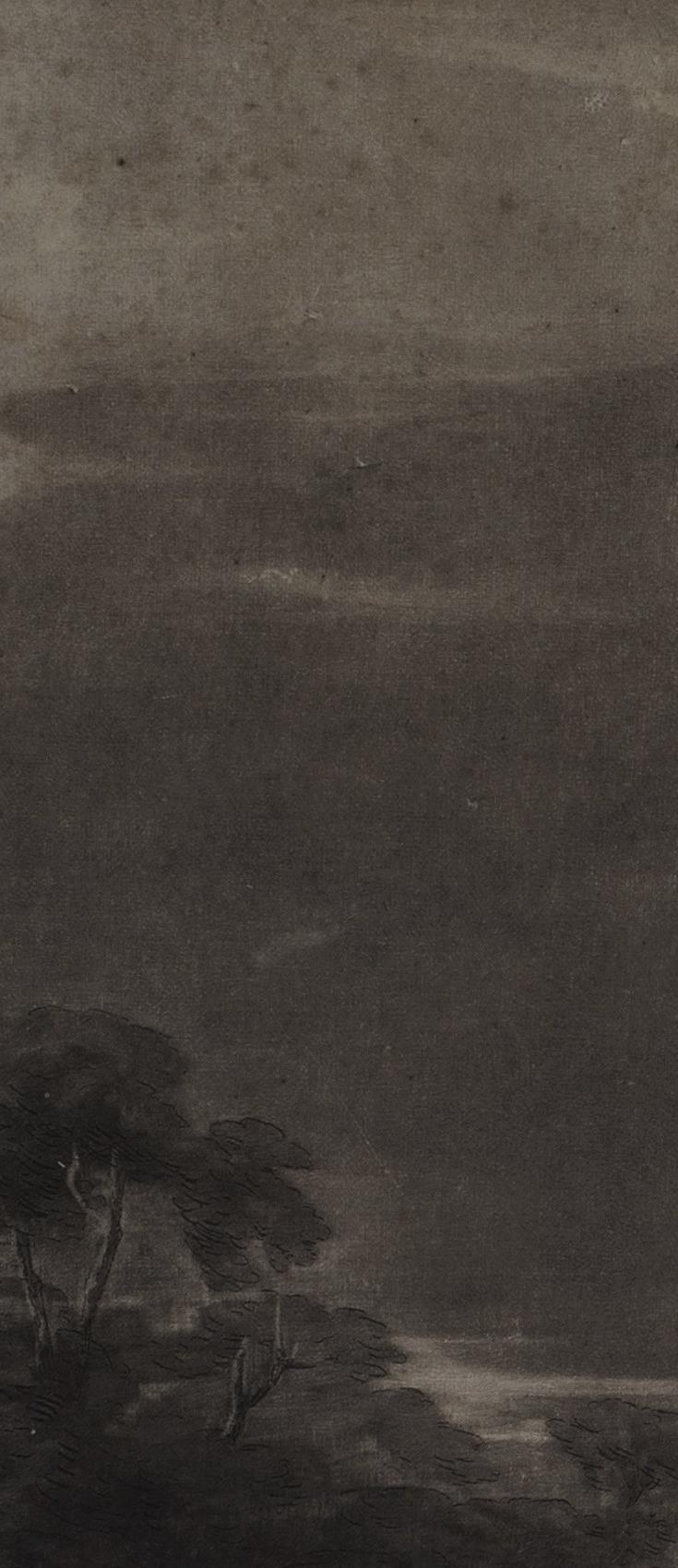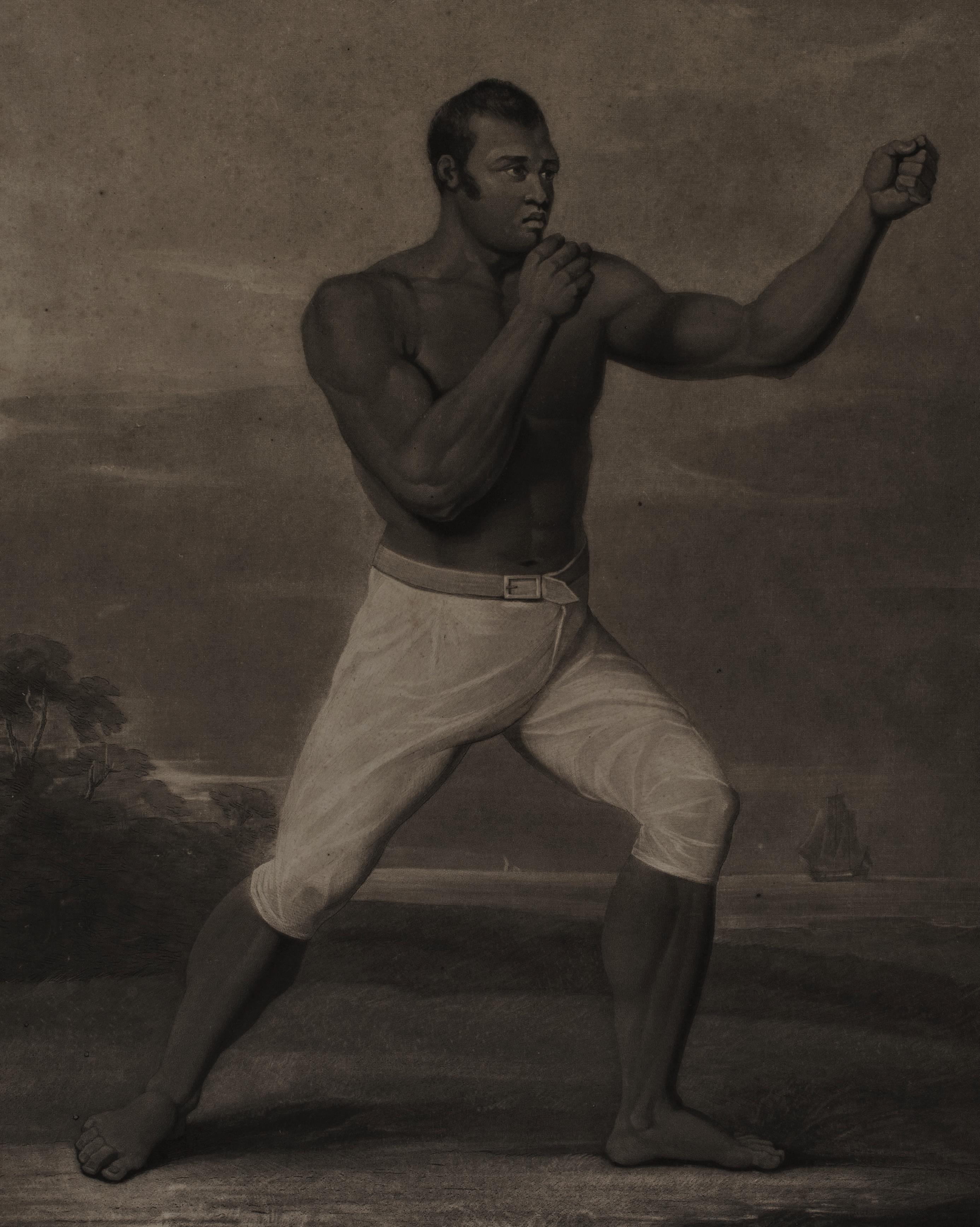

On the occasion of the Spring online Print Fair organized by the International Fine Prints Dealers Association, we are pleased to present this small catalog whose first part gathers several prints on printmaking.
The first one, of which you can see details here, is a superb impression of the famous print Sculptura in æs, engraved ca. 1591 after a drawing by Johannes Stradanus, which is the first detailed and realistic depiction of an engraving workshop. This impression is the rare first state (of 4) before the number 19 in the lower left margin. We present also one of the rare copies of the Lettre sur les éléments de la gravure à l’eau-forte [Letter on the Elements of Etching] etched by Adolphe Martial Potémont, which was published in 1864. The set is complete with its cover featuring the trompe l'oeil letter. With this little treatise Martial Potémont actively participated in the revival of etching in France, supported by the creation of the Société des Aquafortistes in 1862.
In the second part of the catalogue, we present an interesting and very rare mezzotint by John Young depicting the black boxer Tom Molineux, who was born into slavery in Maryland and who won his freedom by boxing. He became one of the legendary bare-knuckle boxing champions, first in New York in 1809 and then in London in 1810.
 Sarah Sauvin
Sarah Sauvin


1. After Johannes STRADANUS
(1523 - 1605)
Sculptura in æs - ca. 1591 [The Invention of Copper Engraving] Engraving, 203 x 274 mm. New Hollstein (Johannes Stradanus) 341, 1st state (of 4).
Impression of the 1st state (of 4), before the number 19 in the lower left margin, with Philips Galle’s address, before Johannes Galle’s address. Impressions of the 1st state are very rare.
Superb impression printed on laid watermarked paper (watermark: gothic P). In excellent condition. Small margins around the platemark (sheet: 218 x 287 mm).

Sculptura in æs is part of a series of twenty engravings; the first plate in the series has the title Nova Reperta. This series was engraved by several artists after Johannes Stradanus; not all of them have been identified. Some plates are signed by Theodoor Galle (plate number 1) and Jan II Collaert (plates 15, 17 and 18). Four other plates have also been attributed to the latter: the plates with numbers 2, 12 and 16, as well as the title plate (see New Hollstein, The Collaert Dynasty, nos. 1205-1211).
The series was first published around 1591 by Philippe Galle in Antwerp and was then successively republished by Karel de Mallery (after 1612), Theodoor Galle (before 1636) and Johannes Galle (before 1677).
The Nova Reperta series illustrates several noteworthy discoveries and inventions in late 16th century Europe: ranging from the exploration of the Americas to the cultivation of sugarcane, including the invention of the compass or the development of gunpowder. Impressio librorum and Sculptura in æs represent a typographical printer’s shop for the former, and a workshop for intaglio printmaking for the latter.



Sculptura in aes represents the different operations carried out in a printing workshop. In the foreground, an engraver is teaching the technique to two children, while a third child, seated at a small desk on the left, is busy copying a drawing. The other workers are busy with the different tasks, each one corresponding to one of the successive stages of printing a copper plate: preparation of ink and sheets, varnishing, heating and wiping the plate, inking, passing under the press, checking the finished prints, hanging up the sheets to dry. The composition representing the different phases of the printing process both in space and in time creates a movement that evokes not only the hustle and bustle of a workshop but the dynamism of a new industry born of a ‘technical invention’, which is the theme of the Nova Reperta series.
Sculptura in æs puts the emphasis less on the invention of copperplate engraving, and more on the invention of the roller press, which allowed intaglio to soar as an art. Ad Stijnman, who undertook an exhaustive study of the history of the development of manual intaglio printmaking processes in his book Engraving and Etching 1400-2000, notes that, when copperplate engraving appeared in Europe around 1430, it wasn’t done with a press but by hand, by rubbing the back of the paper laid against the copperplate. This would result in very weak impressions of unequal quality.
The use of roller presses was probably inspired by textile printing presses and started around 1460-1465. According to Jacques Bocquentin, as quoted by Ad Stijnman, the first roller press appeared in 1460-1465 in the Upper Rhine region, possibly in the workshop of the Master E.S. (Stijnman p. 39).



The first known depiction of an engraver’s workshop is a small woodcut, attributed to Arnold Nicolai, that was introduced in the 2nd edition of Emblemata, et aliquot nummi antiqui operis by Johannes Sambucus, published by Plantin in 1564 in Antwerp. The scene is rather simplistic and features only one character. Sculptura in æs is the first detailed and realistic depiction of an engraving workshop, where the division of tasks evokes the level of sophistication of the process as well as the distribution of a high number of impressions.
Madeleine C. Viljoen sees this print as "both a meta -engraving, illustrating how engravings are made, and the first image to publicize the mise-en-scène of early modern engraving." (p. 61) She considers that there is a "mise-en-scène" in the fact that "the scene of calm that Stradanus's Sculptura in æs presents belies the realities of early modern printing shops, which scholars have shown were noisy, mucky, and rowdy" (p. 63-64). According to her, this idealised vision corresponds to a new expression of the union of labor and diligentia. "The union of diligence and labor is a common conceit in mid-sixteenth-century Flemish and Netherlandish prints." (p. 70) The letter of Hendrick Goltzius’s Labor et Diligentia (1582) reads : « When labor and diligence are not spared, the arts will bring forth diverse inventions” (translated from Dutch by Madeleine C. Viljoen, p. 70).
References: Ad Stijnman , “Stradanus’s Print Shop”, Print Quarterly, vol. XXVII (2010) no. 1, pp. 11-29; Ad Stijnman: Engraving and Etching 14002000, A History of the Development of Manual Intaglio Printmaking Processes, 2012; Madeleine C. Viljoen: "Diligent labor in Stradanus's Engraving Shop" in Renaissance Invention: Stradanus's Nova Reperta, pp. 61-73, 2020.

2. Joannes and Lucas van DOETECUM
(1530 - 1605) - (active 1554 - 1572 - died before 1589)
Imaginary view of a street with the house Aux Quatre Vents1560
Etching and engraving after Hans Vredeman de Vries, 210 x 257 mm. New Hollstein (Van Doetecum) 163, 2nd state (of 2).
Impression of the 2nd state (of 2), with the excudit of Theodoor Galle replacing Hieronymus Cock’s motto bottom right.
Fine impression printed on watermarked laid paper (watermark: cross of Lorraine). A small fold in the bottom right corner, two tiny stains in the upper part and an area of paper thinning in the bottom margin, otherwise in very good condition. Margins around the platemark (sheet: 259 x 278 mm).

The Imaginary view of a street with the house Aux Quatre Vents is the first plate of a series of twenty perspective views designed by Hans Vredeman de Vries and etched by the brothers Joannes et Lucas van Doetecum: Scenographiae sive perspectivae ut Aedificia, hoc modo ad opticam excitata. Pictorum vulgus vocat pulcherrimae viginti selectissimarum fabricarum. This series, also known as “The Large Perspective Book” was first published by Hieronymus Cock. It “evoke[s] a new world of modern interiors and buildings presented in a wide variety of settings and spaces.” (Peter Fuhring, Hieronymus Cock, p. 196)
The first plate in the series depicts an imaginary view of Hieronymus Cock’s well-known print publishing house. Jan van der Stock describes it as follows: “This plate […] has Cock posing in the doorway of the house Aux Quatre Vents, identified by a sign with the heads of four putti blowing in the four cardinal directions, with, below them, the French inscription IIII vens.



Cock’s wife, Volcxken Diericx, stands behind the counter inside the shop in front of shelves on which packs of prints are stacked. A monumental representation of the Raising of the Brazen Serpent can be made out through the doorway on the right […] The richly ornamented architecture is the product of Vredeman de Vries’s imagination but is based at least partially on reality.” (Hieronymus Cock, p. 76)
The couple of publishers had in fact initially chosen the Nieuwe Beurs district, the new commercial heart of the city [of Antwerp]. It was here, on the northern corner of the Sint-Kathelijnevestthen still called Cattestraat - and the Lange Nieuwstraat, that the publishing house Aux Quatre Vents was established. Engravings were printed there from 20 November 1556 until 24 October 1565. (Hieronymus Cock, p. 17).
On our impression, the inscription IIII vents has been erased by the new publisher of the series, Theodoor Galle (1571-1633), who was the godson of Volcxken Diericx and the eldest son of Philippe Galle. The latter was one of the executors of Hieronymus Cock's widow's wishes when she died in 1600. Theodoor Galle then acquired more than 300 plates from Hieronymus Cock's stock, which he reissued by replacing the name of the former publisher with his own. Theodoor Galle's stock passed in 1636 to his eldest son, Joannes (Peter Fuhring, “The stocklist of Joannes Galle […]”, p. 228).
References: Hieronymus Cock, The Renaissance in Print, 2013; Peter Fuhring: “The stocklist of Joannes Galle, print publisher of Antwerp, and print sales from old copperplates in the seventeenth century”, in Simiolus, vol. 39, no. 3, 2017, pp. 225-309.


3. Jacques CALLOT
(1592 - 1635)
Frontispiece for the series Varie Figure

Etching, 88 x 97 mm. Meaume 730, Lieure 403, 2nd state (of 3). Impression of the 2nd state (of 3), with the word fecit added on the sign but before the number 1 in the bottom right corner. Very fine impression printed on laid paper. A small repaired loss of paper in the bottom right corner of the sheet and a trace of old gluestain shining through in the upper margin. Small margins (sheet: 108 x 121 mm).
« An open-air print dealer sits on the left in front of a table on which he has displayed the prints for sale. Second-hand enthusiasts come up and look around. On the right is a bale carrier who appears to be asking for the price of the volume he is holding. Above the table is a sign on which is written VARIE FIGURE / DI IACOPO / CALLOT. » (Jules Lieure, Jacques Callot, Catalogue de l’œuvre gravé, vol. 1, p. 81, translated by us).



4. Nicolas-Toussaint CHARLET
(1792 - 1845)
The Seller of Lithographic drawings - 1818/19
Lithograph, 237 x 310 mm. La Combe 85, IFF 66.
Very fine impression printed on white wove paper. A small 10 mm tear repaired in a summary way in the bottom margin (in the blank part, to the left) and a few small stains in the margins. Impression trimmed half a millimetre inside the platemark bottom (loss of the tip of the g in Lithographiques) and small margins on the three other sides (sheet: 257 x 345 mm).

Nicolas-Toussaint Charlet sketched his favourite subjects, a sapper and a conscript, with a lot of humour, as they pore over lithographs that represent them in their daily life: marching into combat, taking care of horses, etc. As for the print dealer, he seems to be sleeping in his open-air market.
This famous lithograph was printed at François-Séraphin Delpech's printing workshop (1778-1825). It can be dated to 1818-1819, which makes it a lithographic incunabulum. FrançoisSéraphin Delpech had his own shop and printing workshop at 3, Quai Voltaire in Paris, which Carle Vernet depicted in an 1818 lithograph: Imprimerie lithographique de F. Delpech. Rare (marked 'R' in La Combe's catalogue raisonné).



5. Horace VERNET (1789 - 1863)
Croquis Lithographiques par H. Vernet - 1818 [Lithographic Sketches by H. Vernet]
Lithography, 160 x 192 mm (at the boderline). Bruzard 22, Beraldi 117
Very fine impression printed on wove paper. A few foxmarks in the margins; full margins (sheet: 268 x 365 mm).

The scene shows a commissionaire carrying three lithographic stones on his back. On the quay, probably one of the quays of the Seine in Paris, bibliophiles are rummaging through the boxes of the booksellers.
Louis-Maurice Bruzard indicates that "this piece served as a frontispiece to the first Album entirely composed of works by M. Horace Vernet." (translated by us). The printer was François Seraphin Delpech (1778 - 1825).



6. Adolphe Martial POTÉMONT, known as Martial (1828
- 1883)
Lettre sur les éléments de la gravure à l’eau-forte - 1864

[Letter on the Elements of Etching]
Etching, 201 x 164 mm (frontispiece), 293 x 200 mm (image of each inside plate). Beraldi 19.
Complete series of four plates contained in a folder with an etched frontispiece, published by Cadart et Luquet and printed by Beillet et Forestier. The four inner plates, numbered 1 to 4 in the subject, are printed on watermarked laid paper (watermark: [ARC]HES.) The folder containing them is in fine tan wove paper. Plates generally in excellent condition, two tiny tears in the right margin of one plate and some very rare pale foxmarks. Full uncut margins (sheet: 455 x 310 mm). Folder: a few small repaired tears on the edges and the inner fold and a repaired loss of paper in the lower right corner. Dimensions of the folded cover: 502 x 325 mm. Very rare. The folder is decorated with a frontispiece reproducing in trompel'oeil a small unfolded letter accompanied by its envelope. It is a short note written by a man named Martial to Messieurs Cadart et Luquet. He addresses to them a second letter written to him by un eau-fortiste de [ses] amis [an etcher, a friend of his], a man named A. Potémont. The title of this letter is written on the envelope: Lettre sur les éléments de la gravure à l'eau-forte.
Martial asks their opinion on the interest of publishing a facsimile, as the author allowed him. These are the four plates imitating the pages of a letter contained in the folder.
Adolphe Martial Potémont not only exploits two classic rhetorical devices: the letter within the letter and the double to which he gives his name, but he also uses a trompe-l'œil to give credence to his story: how can one doubt the existence of a letter whose image he shows?



Little is known about the genesis of this ‘letter’. The envelope and the letter signed Martial which serve as the title page of the series bear the date June 1864. The four-page letter signed A. Potémont is dated 1860. It is most certainly the "Traité d'eau-forte par Martial. Résumé en quatre feuilles in-folio" [Treatise about the etching, by Martial. Summarised in four folio sheets] described among the novelties "on sale at MM. Cadart and Luquet" at the end of the 1865 Almanach de la Société des Aqua-fortistes: "This little treatise, presented in the familiar form of a letter to a friend, gives anyone who knows how to draw the professional techniques of etching, with an example etched opposite the explanation. With this treatise, two hours are enough to know everything that is theoretical about etching. Practice and experience do the rest." (translated by us)
Martial Potémont humorously explains some basic advice that should allow beginners to "not waste too much time on the miseries of this craft" and to soon "resurrect Callot, Israel or Rembrandt! ". Images of tools and etchings illustrate his point.



He describes the necessary equipment and the different stages of etching: preparation of the plate with varnish, etching, biting, printing of proofs and retouching if needed. The copperplates can be bought from a reputable planer, the Godard company, rue de la Huchette, in Paris. As for the tools and products needed, they can be found at Cadart et Luquet, 79 rue de Richelieu, headquarters of the Société des Aquafortistes: etching needles of various sizes, scraper, burnisher, hand vice and varnish ball, cotton swab, turpentine and bottle of nitric acid. At the same address, amateurs will find an etching workshop where they can receive advice.
The first stage consists of varnishing the plate held in a vice: it must be cleaned, heated and then coated with varnish using a ball that is melted on the hot plate; the plate must then be smoked: the lines that will be drawn in the varnish that has become black will thus expose the red copperplate and appear in contrast. The second step is the etching, i.e. drawing on the plate with tools of different sizes. It is possible to draw directly or to transfer a drawing onto the plate using vegetable paper and sanguine or pastel. Repentances are allowed by applying varnish with a brush on a failed line.



Potémont recommends using the thickest needle in the foreground to the thinnest in the background in order to create gradations, but he adds jokingly: "Whatever you do, make yourself understood and it will be fine - you see I'm accommodating!"
Next comes the bite. After protecting the edges of the plate and possibly the reverse side, it is placed in a basin containing a liquid composed of half water and half nitric acid.

Potémont advises biting the plate for five minutes at a time (ten minutes in winter) in order to control the progress of the bite and to gradually cover the parts that have been sufficiently bitten.
The next step is printing, which can be done at a printer's or at home if we have a press. Potémont emphasises the importance of printing, and therefore of the printer, using as an example the central illustration on the fourth plate, about which he says: "It was the printer who created the shadows with the printing ink in accordance with the shadows I drew on the first proof". It should be noted that the impressions of this illustration are very different from one copy of the Letter


to another: the areas where a veil of ink has been preserved and those where the plate has been carefully wiped off are not exactly the same on our print and on the two copies in the Rijksmuseum.


If the impressions do not entirely satisfy the artist, writes Potémont, he can retouch his plate either by deepening some strokes or by adding new ones, or by softening certain parts with the burnisher or the scraper, or by pushing back the copper on the back of the plate. Finally, he insists on the patience required by the aquafortist in all the stages of the etching process. When it comes to the bite, the only precept, for those who absolutely want one, would be: "look at it over and over again and look at it again". This is also the final word: "Just one friendly word to finish- make several attempts; have some patience; the thing is worth it."
Reference: Janine Bailly-Herzberg: L’Eau-forte de peintre au dix-neuvième siècle. La Société des Aquafortistes, 1862-1867, Paris, 1972.











 John Young : The Match between John Broughton vs George Stevenson
John Young : The Match between John Broughton vs George Stevenson



 John Young : Richard Humphrey
Richard Dighton : Molineaux
John Young : Richard Humphrey
Richard Dighton : Molineaux



